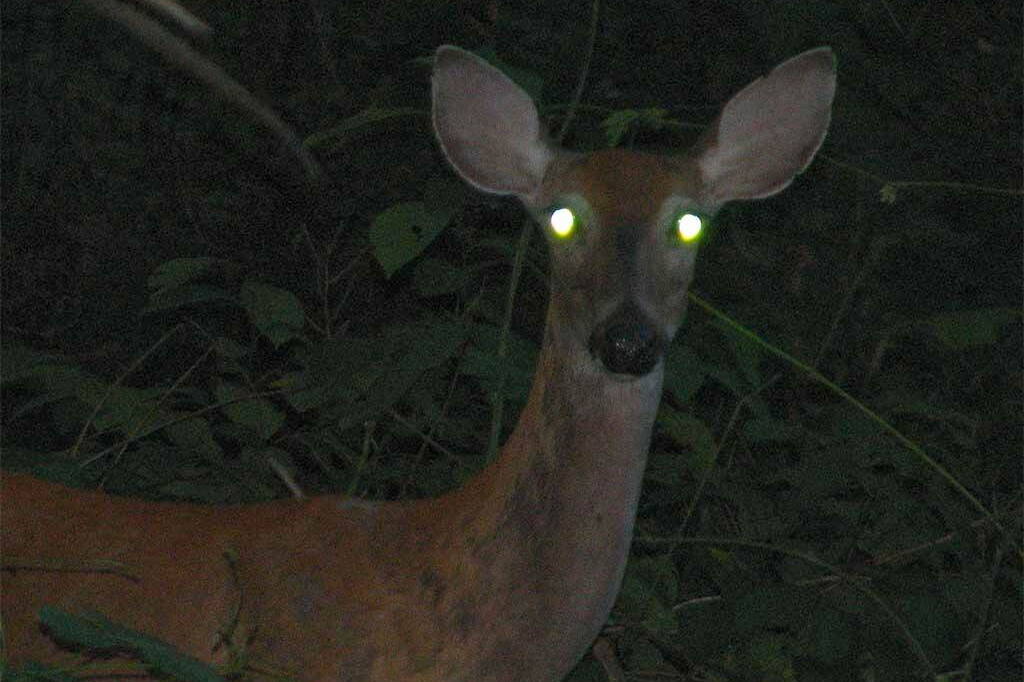The eyes of a wary cat or dog on the roadside at night can reflect the light of oncoming cars, often with startling vividness. That’s called eyeshine. At the back of the animal’s eye is a special reflective membrane, the tapetum lucidum. Light rays entering the eye pass through the retina, where the photoreceptor cells are, and then are reflected back through the retina again, giving the animal better vision, especially in dim light. (Note: this is not the same as the so-called red-eye effect resulting from flash color photography).
The eyes of many animals have this special structure. It’s well-developed in many mammals (but not in most primates, including humans), nocturnal birds, crocodilian reptiles, frogs, and some fishes. Many spiders have a tapetum in their lateral eyes, good for detecting prey movement, but not in their front, central eyes, which then are used to focus an attack.
The chemical and physical properties of the tapetum are greatly varied. Leaving aside those details, suffice it to say that the color of the reflected light also varies a lot: yellow, red, pink, green, blue, etc. The color is a result partly of the composition of the tissue and partly of the angle of reflection. That begs a question: does the color of the reflected light have some particular function in addition to the general enhancement of vision?
I’ve found one example in which the color of reflected light probably has a distinctive function. Eurasian reindeer are apparently unique in having a tapetum that changes color with the season: it’s yellowish in summer, but blue in winter, when the sun is generally below the horizon, making a long twilight with lots of short blue and UV wavelengths. The blue tapetum allows much of the ambient blue and UV light to be registered by the photosensitive cells, so reindeer in winter see a glowing, purplish landscape and there is a good contrast with UV-absorbing objects in the landscape. They eat a lot of lichens, and a number of their favorite lichens absorb UV rays, making them look dark (to a winter-adapted reindeer’s eyes) in a snowy, brighter landscape. Researchers suggest that these lichens are thus more conspicuous to reindeer and easier to find from a little distance. And at close range, the grazers could readily zero in on their food source.
Some researchers also suggest that perhaps predators somehow become more detectable. That may depend on the degree to which the fur of bears and wolves absorbs UV, making them stand out on a snowy background. The fur of many mammals, including polar bears, is fluorescent under UV light, absorbing the short wavelengths and re-emitting longer wavelengths, such that the animals would glow (in the visible spectrum) but perhaps looking dark to UV-sensitive eyes. However, the magnitude and potential effectiveness of those effects under ambient light conditions seems to be unreported.
Thinking about reindeer led to another feature of their biology, one that is shared with many other grazing mammals (cows, sheep, goats, antelope, giraffes, deer, etc.). Grazing mammals have very specialized digestive systems that help them deal with fibrous, tough plant material. The first part of the stomach, called the rumen, is a large chamber filled with microbes of many types. The big chamber allows the grazer to eat a lot at one time and store it, and the microbes go to work. When the grazer bites off some foliage and chews it briefly, mixing it with saliva, the partly chewed material goes to the rumen, when all those microbes start breaking down the cellulose and sugars; the fermentation process often leads to the production of gases and therefore the animal burps. The partially digested material is passed back up to the mouth for chewing again…and so the animal chews its “cud” — the process is called rumination. The lump of cud may go back and forth between rumen and mouth several times, before being passed on to the rest of the digestive tract. (Note: a fully herbivorous bird, the South American hoatzin, uniquely among birds, also uses microbial foregut fermentation to digest leaves, but it does not regurgitate and re-swallow a cud.)
Cud-chewing mammals can process food this way all day long, even when they are asleep. Some recent work has shown that Eurasian reindeer can enter very deep sleep while cud-chewing. Interestingly, that deep sleep apparently involves the whole brain, not just half of it, as happens in some other animals. The suggestion is that cud-chewing while in deep sleep allows the grazer to spend less time in lighter sleep and more time foraging. That could be especially important in summer, when the animals need to eat a lot in order to be ready for winter (and for females to nurse their young).
• Mary F. Willson is a retired professor of ecology. “On The Trails” appears every Wednesday in the Juneau Empire.

